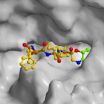(Press-News.org) Like an overprotective parent on the first day of school, a targeting factor sometimes needs a little push to let go of its cargo. Scientists at the European Molecular Biology Laboratory (EMBL) in Grenoble, France, have visualised one such hand-over. They were the first to determine the structure of a ribosome-protein complex involved in carrying nascent proteins out of the cell. Their work, published today in Nature Structural and Molecular Biology, could increase understanding of illnesses such as cystic fibrosis and some forms of Parkinson's disease, in which improper protein targeting leads proteins to harmfully accumulate inside cells.
In most organisms, proteins destined to cross or be embedded in a membrane contain a polypeptide sequence that is recognized during translation by a targeting factor known as the signal recognition particle (SRP). SRP binds to the ribosome synthesizing the polypeptide, and subsequently also binds an SRP receptor, located next to the machinery that transfers proteins across the membrane and out of the cell. EMBL scientists have now generated the first-ever structural image of this important step in the process.
"The SRP receptor acts as a switch between the cargo binding and the release," says Christiane Schaffitzel, who led the research at EMBL, "Now we have seen for the first time how the release can happen at a molecular level."
Schaffitzel's group is taking structural snapshots of entire pathways by which proteins are synthesized and targeted to their final positions. To capture this hand-over step, the scientists had to overcome the fact that the link between SRP and its receptor is usually transient, chemically unstable. They engineered the SRP receptor so that it would bind more stably to SRP, then introduced ribosomes and observed the resulting complexes using cryo-electron microscopy (cryo-EM).
Cryo-EM can be performed in roughly physiological conditions, providing a picture that closely resembles what happens in living cells. This picture can then be combined with higher-resolution crystallography data and biochemical studies – an exciting hybrid approach the EMBL scientists will further exploit to follow protein targeting all the way from start to finish.
INFORMATION:
A particular asset for success in this project was the close collaboration with Guy Schoehn at the Institut de Biologie Structurale (IBS). IBS and EMBL are part of the Partnership for Structural Biology (PSB) in Grenoble, France.
How cells export and embed proteins in the membrane
EMBL scientists first to visualise crucial step
2010-12-14
ELSE PRESS RELEASES FROM THIS DATE:
Smoking behind more than a third of severe rheumatoid arthritis cases
2010-12-14
Smoking accounts for more than a third of cases of the most severe and common form of rheumatoid arthritis, indicates research published online in the Annals of the Rheumatic Diseases.
And it accounts for more than half of cases in people who are genetically susceptible to development of the disease, finds the study.
The researchers base their findings on more than 1,200 people with rheumatoid arthritis and 871 people matched for age and sex, but free of the disease. The patients came from 19 health clinics in south and central Sweden, while their healthy peers were ...
UK ill prepared for 'epidemic' of degenerative valvular heart disease
2010-12-14
The UK is poorly prepared for the forthcoming epidemic of degenerative valvular heart disease, prompted by a rapidly ageing population, say leading experts in the journal Heart.
The prevalence of valvular heart disease, or VHD for short, rises with age. European and US data indicate that more than 13% of those aged 75 and above have the progressive condition. And by 2018, there will be an estimated 4 million people in the UK aged between 75 and 84.
The exact causes of VHD have been poorly researched, but the condition is associated with a great deal of ill health, poor ...
UK medical student ophthalmology teaching falling short
2010-12-14
UK medical schools are failing to comply with the recommended curriculum for ophthalmology, set out by the International Council of Ophthalmologists (ICO), suggests a survey published online in the British Journal of Ophthalmology.
Amid concerns that the specialty was being squeezed out of undergraduate education, the council urged medical schools to make it a core subject and produced guidance to help them do this.
But a questionnaire sent to 32 UK medical schools, which prompted 18 to complete returns, shows that while all include ophthalmology in the curriculum, ...
Unlawful killing of newborns soon after birth 5 times higher than thought
2010-12-14
Although rare, the true incidence of neonaticides - the unlawful killing of a baby within the first 24 hours of its life - is more than five times as common as official estimates suggest, suggests research published online in the Fetal and Neonatal edition of the Archives of Disease in Childhood.
Low maternal self esteem and emotional immaturity, rather than obvious mental illness or social disadvantage, are key drivers, the research indicates.
The researchers reviewed the case records of 26 courts in three regions of France, involving the death of a child within the ...
A new mechanism for reversible proteasome inhibition
2010-12-14
What makes cancer cells so dangerous is that they grow in an unregulated way and proliferate much faster than other cells. The proteasome, a large protein complex, plays a key role in this process: By breaking down used proteins for recycling, it clears the way for the next cycle. New hope was spawned several years ago with the discovery that inhibiting proteasomes can be used as a means to put the brakes on cell growth. In the mean time, the first drug using this approach, Bortezomib, generates revenues in excess of one billion U.S. dollars per year. However, it also inhibits ...
A study analyzes the movement of tree sap
2010-12-14
The researchers decided to embark on this study in order to find out which mechanisms are used by plants when they extract water from very dry or somewhat inhospitable land. "In the case of mangrove swamps, for example, the plants are able to extract freshwater from a saltwater environment, despite the fact that the osmotic pressure should make quite the opposite happen", explains Professor José Luis Pérez Díaz, who studies this type of relatively unknown phenomenon as part of a new line of research that the Department of Mechanical Engineering at UC3M has begun.
The ...
Choose a movie's plot -- while you watch it
2010-12-14
Tel Aviv ― Will Rona and Sol kiss and seal their fate as a couple forever, or will Sol answer the ringing phone and change the course of history? A new movie format developed by Tel Aviv University lets the viewer decide.
Utilizing complicated video coding procedures, the new format provides smooth interaction and transition between scenes as audience members watch ― and determine the plot of ― Turbulence, created by Prof. Nitzan Ben Shaul of Tel Aviv University's Department of Film and Television. Made with his unique scene-sequencing technique, Turbulence ...
Earthshaking possibilities may limit underground storage of carbon dioxide
2010-12-14
Storing massive amounts of carbon dioxide underground in an effort to combat global warming may not be easy to do because of the potential for triggering small- to moderate-sized earthquakes, according to Stanford geophysicist Mark Zoback.
While those earthquakes are unlikely to be big enough to hurt people or property, they could still cause serious problems for the reservoirs containing the gas.
"It is not the shaking an earthquake causes at the surface that creates the hazard in this instance, it is what it does at depth," Zoback said. "It may not take a very big ...
Britain at political crossroads
2010-12-14
The National Centre for Social Research today released its latest British Social Attitudes report, its landmark study of the public's attitudes and values, published annually for almost thirty years.
This year's report delivers the public's verdict after thirteen years of Labour rule. It shows a nation at a political crossroads. On the one hand attitudes on welfare have hardened to the right. On the other, many think there were marked improvements in health and education under Labour, creating potential resistance to reform or cuts in these areas.
A shift to the right ...
R-E-S-P-E-C-T: The health of health care depends on it
2010-12-14
INDIANAPOLIS – Along with integrity and compassion, respect for patients, colleagues and other team members is an essential attribute of medical professionalism. A new study examines how medical students learn respectful or disrespectful professional behavior.
"Exploring the Meaning of Respect in Medical Student Education: An Analysis of Student Narratives" appears in the December 2010 issue of the Journal of General Internal Medicine. From the observations and conclusions of third-year medical students, the article provides insight into how future physicians acquire ...
LAST 30 PRESS RELEASES:
Interaction of climate change and human activity and its impact on plant diversity in Qinghai-Tibet plateau
From addressing uncertainty to national strategy: an interpretation of Professor Lim Siong Guan’s views
Clinical trials on AI language model use in digestive healthcare
Scientists improve robotic visual–inertial trajectory localization accuracy using cross-modal interaction and selection techniques
Correlation between cancer cachexia and immune-related adverse events in HCC
Human adipose tissue: a new source for functional organoids
Metro lines double as freight highways during off-peak hours, Beijing study shows
Biomedical functions and applications of nanomaterials in tumor diagnosis and treatment: perspectives from ophthalmic oncology
3D imaging unveils how passivation improves perovskite solar cell performance
Enriching framework Al sites in 8-membered rings of Cu-SSZ-39 zeolite to enhance low-temperature ammonia selective catalytic reduction performance
AI-powered RNA drug development: a new frontier in therapeutics
Decoupling the HOR enhancement on PtRu: Dynamically matching interfacial water to reaction coordinates
Sulfur isn’t poisonous when it synergistically acts with phosphine in olefins hydroformylation
URI researchers uncover molecular mechanisms behind speciation in corals
Chitin based carbon aerogel offers a cleaner way to store thermal energy
Tracing hidden sources of nitrate pollution in rapidly changing rural urban landscapes
Viruses on plastic pollution may quietly accelerate the spread of antibiotic resistance
Three UH Rainbow Babies & Children’s faculty elected to prestigious American Pediatric Society
Tunnel resilience models unveiled to aid post-earthquake recovery
Satellite communication systems: the future of 5G/6G connectivity
Space computing power networks: a new frontier for satellite technologies
Experiments advance potential of protein that makes hydrogen sulfide as a therapeutic target for Alzheimer’s disease
Examining private equity’s role in fertility care
Current Molecular Pharmacology achieves a landmark: real-time CiteScore advances to 7.2
Skeletal muscle epigenetic clocks developed using postmortem tissue from an Asian population
Estimating unemployment rates with social media data
Climate policies can backfire by eroding “green” values, study finds
Too much screen time too soon? A*STAR study links infant screen exposure to brain changes and teen anxiety
Global psychiatry mourns Professor Dan Stein, visionary who transformed mental health science across Africa and beyond
KIST develops eco-friendly palladium recovery technology to safeguard resource security
[Press-News.org] How cells export and embed proteins in the membraneEMBL scientists first to visualise crucial step



